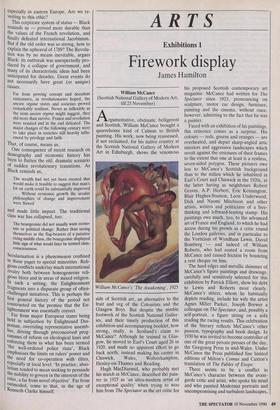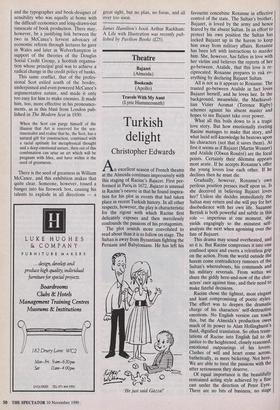ARTS
Exhibitions 1
Firework display
James Hamilton
William McCance (Scottish National Gallery of Modern Art, till 25 November)
Argumentative, obstinate, belligerent and Scottish, William McCance brought a quarrelsome kind of Cubism to British painting. His work, now being reassessed, if not reclaimed, for his native country at the Scottish National Gallery of Modern Art in Edinburgh, shows the venomous William McCance's 'The Awakening', 1925 side of Scottish art, an alternative to the fruit and veg of the Colourists and the Glasgow Boys. But despite the nimble footwork of the Scottish National Galler- ies, and their timely production of this exhibition and accompanying booklet, how strong, really, is Scotland's claim to McCance? Although he trained in Glas- gow, he moved to Earl's Court aged 26 in 1920, and made no apparent effort to go back north, instead making his career in Chiswick, Wales, Wolverhampton, Henley-on-Thames and Reading.
Hugh MacDiarmid, who probably met his match in McCance, described the pain- ter in 1925 as 'an ultra-modern artist of exceptional quality' when trying to woo him from The Spectator as the art critic for his proposed Scottish contemporary art magazine. McCance had written for The Spectator since 1923, pronouncing on sculpture, motor car design, furniture, painting and the cinema, without once, however, admitting to the fact that he was a painter.
Faced with an exhibition of his paintings, this reticence comes as a surprise. His colours — reds, greens and oranges — are overheated, and depict sharp-angled attic interiors and aggressive landscapes which revolt against the strictures of their frames to the extent that one at least is a restless, seven-sided polygon. These pictures owe less to McCance's Scottish background than to the milieu which he inhabited in Earl's Court and Chiswick in the 1920s, at the latter having as neighbours Robert Graves, A.P. Herbert, Eric Kennington, Blair Hughes-Stanton, Leon Underwood, Dick and Naomi Mitchison and other artists, writers and politicians of a free- thinking and leftward-leaning stamp. His paintings owe much, too, to the advanced art of France and England, to which he had access during his prowls as a critic round the London galleries, and in particular to the Vorticism of Wyndham Lewis, David Bomberg — and indeed of William Roberts, who had rented a room from McCance and caused friction by bouncing a rent cheque on him.
The hard edges and metallic shimmer of McCance's figure paintings and drawings, carefully and sensitively selected for this exhibition by Patrick Elliott, show his debt to Lewis and Roberts most clearly. McCance's sitters, whom he habitually depicts reading, include his wife the artist Agnes Miller Parker, Joseph Brewer a colleague on The Spectator, and, possibly a self-portrait, a figure sitting on a sofa reading the racing results. This celebration of the literary reflects McCance's other passion, typography and book design. In 1930 he was invited to become controller of one of the great private presses of the day, the Gregynog Press in mid-Wales. Under McCance the Press published fine limited editions of Milton's Comus and Caxton's translation of The Fables of Esope.
There seems to be a conflict in McCance's character between the avant- garde critic and artist, who spoke his mind ,and who painted Modernist portraits and uncompromising and turbulent landscapes, and the typographer and book-designer of sensibility who was equally at home with the difficult economics and long-drawn-out timescale of book production. There may, however, be a justifying link between the two in McCance's fervent advocacy of economic reform through lectures he gave in Wales and later in Wolverhampton in support of the theories of the Douglas Social Credit Group, a Scottish organisa- tion whose principal goal was to achieve a radical change in the credit policy of banks.
This same conflict, that of the profes- sional Scot exiled south of the border, underpinned and even powered McCance's argumentative nature, and made it only too easy for him to make enemies. It made him, too, more effective in his pronounce- ments, as in this blast from London pub- lished in The Modern Scot in 1930:
When the Scot can purge himself of the illusion that Art is reserved for the sen- timentalist and realise that he, the Scot, has a natural gift for construction, combined with a racial aptitude for metaphysical thought and a deep emotional nature, then out of this combination can arise an art which will be pregnant with Idea, and have within it the seed of greatnesss.
There is the seed of greatness in William McCance, and this exhibition makes that quite clear. Someone, however, tossed a banger into his firework box, causing his talents to explode in all directions — a great sight, but no plan, no focus, and all over too soon.
James Hamilton's book Arthur Rackham: A Life with Illustration was recently pub- lished by Pavilion Books (£25).



































































 Previous page
Previous page